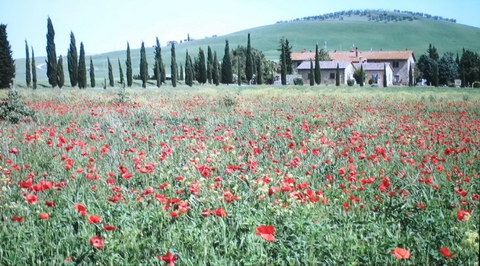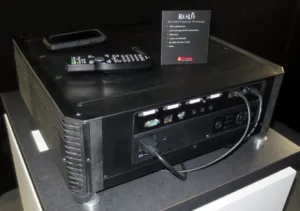At CCW this week (to be known in the future as NAB Show – New York), Canon demonstrated its recently announced 4K LCoS REALiS Projector. The REALiS series of projectors is known as the Power Projector or XEED series in other areas of the world. Meko had previously published an article on this projector (Canon Reveals 4K Projector Plans) but since additional details were available at CCW, an update was needed.
 Photograph of an image from the Canon 4K LCoS Projector at CCW. As expected, the image was sharp and clear plus the colors were good.
Photograph of an image from the Canon 4K LCoS Projector at CCW. As expected, the image was sharp and clear plus the colors were good.
The three-panel LCoS projector uses Canon-made imagers with 4096 x 2400 resolution, slightly higher than even 4K digital cinema. According to the Canon representatives at CCW, the projector is really targeted at the simulation market, not the production and post-production communities who represent the main attendees at CCW. Other markets include venues like museums where high resolution is needed.
The projector uses a single mercury lamp with a lifetime of 3K – 4K hours. Colorimetry is said to match Rec. 709, so the projector can’t be used for preview or color grading of wider color gamut material such as digital cinema or native UHD.
Side view of the projector, showing the connection panel.
The optics of the projector has two unusual features. First, the focus of the lens can be adjusted separately for the center and the edge of the screen. This feature is included specifically to allow sharp focus on curved screens such as dome screens. Since the projector has a f/2.8 optical system compared to f/2.4 typical for DLP or the f/1.8 or less that is common in 3LCD projectors, the lens depth of focus is relatively large anyway. The projection lens is not interchangeable, only a 1.0 – 1.3 throw ratio zoom lens is available for the projector and it comes built-in. The lens has a ±60% vertical and ±10% horizontal lens shift.
The second unusual optical feature is that the three LCoS system uses only two polarizing beam splitters, as opposed to the conventional three. Red and green share one PBS and blue uses the other. The representatives said this allowed the projector to be slightly smaller (18.5 x 6.9 x 21 inches or 47 x 17.5 x 53.3cm) and lighter weight (38.8 pounds or 17.6KG) compared to competitor projectors (e.g. Sony).
The projector offers optical 5-point convergence of the red, green and blue images by using motorized panel holders to correct for any convergence errors. In addition, the projector offers multi-point convergence through pixel interpolation. For simpler installations, the projector has built-in edge blending. For more sophisticated edge blending applications, the Canon representatives said external edge blending could be used.
This projector had been announced September 1 but the formal specifications have not been released. The representatives said the projector will ship in Q1 2016. The price has not been established yet, but is expected to be in the range of about $30K. –Matthew Brennesholtz

